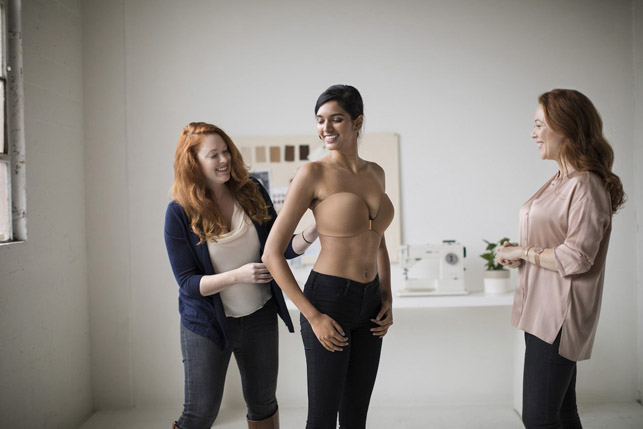Redesigns of traditional products come in all shapes and sizes. From the air compressor to the bra, Tanya Weaver questions what it takes to redesign a product that answers a true need and offers substantial benefits

Evelyn & Bobbie have redesigned the bra. Here is a model being fitted for its new Everyday Bustier by VP of product and design Stephanie Muhlenfeld (left) and company founder Bree McKeen (right)
I’ve been thinking about sewage recently. More specifically, the air that bubbles through sewage (bear with me) at wastewater treatment plants and the machine that makes that possible. This machine is called an air compressor and it pumps large quantities of air into these plants because the natural bacteria that break down the contaminants require it to stay alive.
These air compressors are based on technology that date back to 1935 and there hasn’t been any major innovation since then.
That was until an inventor Steve Lindsey came along and took that traditional technology and redesigned the compressor in a new doughnut-shaped geometry to create the Blade Compressor, which is substantially more efficient.
This set me off wondering about the products we put up with because we’re used to them as there are no suitable alternatives. Things that, if redesigned, could work a lot better for us. The Blade compressor, for instance, following thorough trials with Severn Trent Water, was found to reduce electricity consumption by more than 20 per cent compared to what was being used before.
So from contemplating sewage I started contemplating bras (my mind isn’t always in the gutter, I promise). This was because a few weeks ago an image of the ‘re-engineered bra’ from US start-up Evelyn & Bobbie pinged into my inbox in an email from Fast Company.
It piqued my interest because, although I appreciate that at least half of you reading this don’t have to put up with being pinched, poked or constricted, trust me when I say that no matter the size or shape of the objects in question, the means to keep them strapped in can be bloody uncomfortable. Especially the underwire bra, which hasn’t veered far from its basic design created over 85 years ago!
Bree McKeen, who had a career in finance, thought they were bloody uncomfortable too and so in 2013 founded Evelyn & Bobbie in Portland, Oregon, and began assembling a team of female engineers and designers, including Stephanie Muhlenfeld, formerly Nike’s manager of technical development.
Their mission was to redesign the bra with everything from the materials to the structure and even the colours.
Without a wire in sight, the plan was to also do away with cup sizes. They set about doing this by 3D scanning hundreds of women’s bodies and using that data to create an algorithm that determines each user’s near customised fit.
This data was also used to create a stitchfree fabric with four-way stretch. This involved in-depth research and testing countless materials, even cutting up trainers.
The result is the Everyday Bustier (pronounced boost yay) that features a design with a wide back strap and clasp at the front. It promises sturdy support despite being strapless as the weight is redistributed from the wearer’s shoulder muscles to their core muscles. It also comes in a range of five colours to suit all skin tones.
The Kickstarter campaign, which launched in May, proved that there are definitely other ladies out there keen to burn their bras in a bid for comfort because despite the hefty $88 price tag, the campaign surpassed its target to receive a whopping $407,853 from backers.
What both the above examples illustrate is design that goes back to basics. Forget the traditional design of an air compressor or a bra. Start from a blank sheet of paper and consider the function you want the product to perform or the problem it has to solve.
Come at it with a fresh perspective and, using that oft quoted saying (which certainly grates on me) ‘think outside the box’.
Using arguably the ultimate (re)designer as an example — James Dyson — who, having pioneered cyclonic technology in his vacuums cleaners, took that technology and applied it to other products, completely redesigning them in the process. The fan, the hand dryer, the hair dryer and most recently the electric car.
The announcement that Dyson will be making electric cars from 2020 broke at the end of September. In fact, 400 engineers at its Wiltshire HQ have been secretly working on the £2.5 billion project since 2015.
James Dyson is keeping decidedly schtum about it all but did tell the BBC that the car will be radical and different, because, as he put it, what is the point of making it like any other car?
So, the lesson gleaned from Mr Dyson is not to (using another oft quoted expression) ‘reinvent the wheel’ unless you believe that what you have to offer is indeed more efficient and offers enhanced benefits to the user, the planet etc.
Kickstarter, as well as other crowdfunders, are full of redesigned products, gizmos and gadgets but the truly brilliant ones, the ones that spark the public’s imagination to gain traction are those that answer a real need and are brilliantly executed.
Naturally, all this caused me to think about the products that I’d like to see redesigned.
Top of my list is takeaway plastic coffee cup lids — we use them for such a short amount of time but they’re absolutely terrible for the planet (read my last comment piece on the devastation caused by marine plastic waste).
Next would be the bee smoker, which is a design based on the ‘modern’ singlehandheld smoker launched in 1875. We’ve been here before in 2012, but five years on from moaning about its design I still find myself struggling at keeping the bloody thing alight long enough to carry out my beehive inspections.
I’d be curious to hear your thoughts on products that you think need a redesign. What is at the top of your list?
Refresh and renew, what does it take to upgrade a product for modern use?
Default






